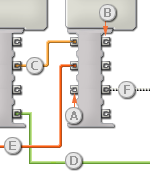This block can determine if a number is greater than (>), less than (<), or equal to (=) another number. The input numbers can be typed in or supplied dynamically by data wires.

A Compare block dropped into the work area will have an open data hub with two input ports (on the left) and three output ports (on the right). Both input ports will have to be connected to other blocks using data wires (except when one of the input ports is supplied by a constant value that you type in).
Output from the comparison will be delivered from the bottommost output plug; connect this plug using a data wire to another block’s data hub. The two output plugs opposite the input plugs allow you to pass the input values on to other blocks if this is necessary. (See the Data Hub section below for more information.)
Configuring the Compare Block

- Input numbers can be typed in or supplied dynamically by data wires. The input boxes will be grayed out when data wires are connected.
- The pull-down menu will let you choose from three comparisons you can perform:
- Greater Than (>)
- Less Than (<)
- Equal To (=)
Greater Than (>)
In this case, if the first input number is greater than or equal to the second input number, the Compare block will return a value of "true." Otherwise, it will return a value of "false."
Less Than (<)
In this case, if the first input number is less than or equal to the second input number, the Compare block will return a value of "true." Otherwise, it will return a value of "false."
Equal To (=)
In this case, if the first input number is equal to the second input number, the Compare block will return a value of "true." Otherwise, it will return a value of "false."
If Input A = Input B, Output = "true"
Configuring the Compare block’s Data Hub
You can control the Compare block dynamically by connecting data wires (from other blocks’ data hubs) to the Compare block’s data hub.
Open a block’s data hub by clicking the tab at the lower left edge of the block after it has been placed on the work area.

Data wires carrying input information to a block are connected to the plugs on the left side of its data hub. Data wires carrying output information are connected to the plugs on the right side.

[A] Input plug
[B] Output plug
[C] Number data wire (yellow)
[D] Logic data wire (green)
[E] Text data wire (orange)
[F] Broken data wire (gray)
Passing data from the input plug to the output plug
If an input plug has a corresponding output plug (see A above), the input data will pass through from the input plug to the output plug without being changed. In this case, you can only use the output plug if the input plug is connected to an input data wire; connecting an output data wire to such an output plug without a connected input data wire will cause the output data wire to be "broken" (and colored gray).
Data wires carry specific types of data
Each data wire carries a specific type of data between blocks. For example, if a data wire is dragged from a logic plug on a block’s data hub, it can only be connected to a logic plug on another block’s data hub. The chart below shows what kind of data each plug can accept or send out.
Data wire colors
Data wires are identified with specific colors: wires carrying number data are colored yellow, wires carrying logic data are colored green, and wires carrying text data are colored orange.
"Broken" data wires
If you try to connect a data wire to a plug of the wrong data type, the data wire will be broken (and colored gray). You will not be able to download your program if a data wire is broken.
If you click a broken wire you can read why it is broken in the small help window in the lower right corner of the work area.
Data must be within the possible range of the plug
If an input data wire transmits a value outside the possible range of the plug it is connected to, the block will either ignore the value or change it to a value within its range. For plugs that allow just a few input values (example: just 0, 1, or 2), the plug will ignore the input if a value arrives outside its range.
For plugs that accept larger input ranges (example: 0 – 100), the plug will force any input outside its range to fit. For example, if a Move block’s Power plug receives an input value of 150, the block will change the input value to 100 (i.e., a number within the Power plug’s range).
This chart shows the different characteristics of the plugs on the Compare block’s data hub:
| Plug | Data Type | Possible Range | What the Values Mean | This Plug is Ignored When... | |
| A | Number | -2147483648 - 2147483647 | Left operand | ||
| B | Number | -2147483648 - 2147483647 | Right operand | ||
| Result | Logic | True/False | Result of operation |